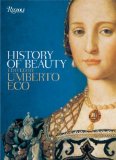“On Beauty” is a lavishly-illustrated book by Umberto Eco and Girolamo de Michele (translated from the original Italian into English by Alastair McEwen) that explores the depiction of beauty in western art through the ages. It uses the art of a period as a reflection of the standards of beauty in that period and shows how these standards have evolved over time. The discussion excludes beauty in nature or literature as well as the depiction of beauty in the art produced by the eastern cultures.
From the idealised depiction of proportions and harmony by the Greek artists to the exploration of light and colour in the Middle Ages and the abstract depiction of beauty in modern times, the idea of what constitutes the beautiful has certainly come a long way, though not necessarily to everyone's liking. The authors explore the “beauty of the bad” (monsters, demons, etc.) in addition to the “beauty of the good” (gods, women, etc.) as they evolved over the centuries.
There is no doubt that this is a well-researched book painstakingly put together by the authors and the editors. Apart from copious reproductions of relevant art, the book also has extensive quotes from various texts of the respective period that reinforce the points made by the authors. The art and the quotes are peppered throughout the text in situ instead of being collected together in plates or endnotes as in some other books.
While setting out to explore “beauty in art”, the book takes a surprising detour into the beauty of machines and the beauty of abstractions. The research is sorely lacking here, omitting some important material and the treatment of the subjects is insipid. For example, a well-crafted clock is an intricately-beautiful mechanism to behold, as are some machines made by people like Tatjana van Vark. Omitting these in a chapter on the beauty of machines is quite close to being sinful. The book uses an image of the Mandelbrot set that has been rendered using primitive methods and that is used as an example of beauty in mathematical abstractions. Modern tools let one create stunningly-beautiful images of fractals that could have served as much better examples.
The text seems somewhat of a letdown considering that the subject is so promising. It comes across as a bit dull and dry, very unlikely to be just an artefact of poor translation. Perhaps this is due to the philosophical undertone adopted by the authors throughout the text. The inclusion of beauty as depicted in mass-media in the final chapters on modern times is quite jarring compared to the rest of the text.
You have to be somewhat familiar with the history of western art and the various artistic movements to make sense of some of the text. Ditto for western philosophy, though to a far smaller degree. Even without this background a reader should be able to follow and appreciate most of the discussion.
